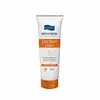What's inside
What's inside
 Key Ingredients
Key Ingredients

 Benefits
Benefits

No benefits
 Concerns
Concerns

 Ingredients Side-by-side
Ingredients Side-by-side

Water
Skin ConditioningParaffinum Liquidum
EmollientIsopropyl Myristate
EmollientStearic Acid
CleansingDecyl Oleate
EmollientGlyceryl Stearate Se
EmulsifyingCetearyl Alcohol
EmollientTocopheryl Acetate
AntioxidantTriethanolamine
BufferingBHT
AntioxidantDisodium EDTA
Methylparaben
PreservativeImidazolidinyl Urea
PreservativePropylparaben
PreservativeParfum
MaskingBenzyl Salicylate
PerfumingButylphenyl Methylpropional
PerfumingHydroxycitronellal
PerfumingLinalool
PerfumingWater, Paraffinum Liquidum, Isopropyl Myristate, Stearic Acid, Decyl Oleate, Glyceryl Stearate Se, Cetearyl Alcohol, Tocopheryl Acetate, Triethanolamine, BHT, Disodium EDTA, Methylparaben, Imidazolidinyl Urea, Propylparaben, Parfum, Benzyl Salicylate, Butylphenyl Methylpropional, Hydroxycitronellal, Linalool
Water
Skin ConditioningTocopheryl Acetate
AntioxidantHelianthus Annuus Flower
Skin ConditioningDimethicone
EmollientGlyceryl Stearate
EmollientPEG-100 Stearate
Isopropyl Myristate
EmollientStearic Acid
CleansingCaprylic/Capric Triglyceride
MaskingEthylhexyl Methoxycinnamate
UV AbsorberGlycerin
HumectantTocopherol
AntioxidantRosa Moschata Seed Oil
EmollientAscorbyl Palmitate
AntioxidantDisodium EDTA
Hydroxypropyl Methylcellulose
Emulsion StabilisingBHT
AntioxidantCarbomer
Emulsion StabilisingTromethamine
BufferingParfum
MaskingPhenoxyethanol
PreservativeSorbitan Caprylate
EmulsifyingWater, Tocopheryl Acetate, Helianthus Annuus Flower, Dimethicone, Glyceryl Stearate, PEG-100 Stearate, Isopropyl Myristate, Stearic Acid, Caprylic/Capric Triglyceride, Ethylhexyl Methoxycinnamate, Glycerin, Tocopherol, Rosa Moschata Seed Oil, Ascorbyl Palmitate, Disodium EDTA, Hydroxypropyl Methylcellulose, BHT, Carbomer, Tromethamine, Parfum, Phenoxyethanol, Sorbitan Caprylate
 Reviews
Reviews

Ingredients Explained
These ingredients are found in both products.
Ingredients higher up in an ingredient list are typically present in a larger amount.
BHT is a synthetic antioxidant and preservative.
As an antioxidant, it helps your body fight off free-radicals. Free-radicals are molecules that may damage your skin cells.
As a preservative, it is used to stabilize products and prevent them from degrading. Specifically, BHT prevents degradation from oxidation.
The concerns related to BHT come from oral studies; this ingredient is currently allowed for use by both the FDA and EU.
However, it was recently restricted for use in the UK as of April 2024.
Learn more about BHTDisodium EDTA plays a role in making products more stable by aiding other preservatives.
It is a chelating agent, meaning it neutralizes metal ions that may be found in a product.
Disodium EDTA is a salt of edetic acid and is found to be safe in cosmetic ingredients.
Learn more about Disodium EDTAIsopropyl Myristate is an emollient, thickening agent, and texture enhancer. It is created from isopropyl alcohol and myristic acid.
It is used to help other ingredients be better absorbed. It is also an emollient and may help soften and hydrate the skin.
The comedogenic rating of this ingredient depends on the concentration. Lower amounts results in a lower rating.
Isopropyl Myristate may not be fungal acne safe. It can potentially worsen acne prone skin.
Learn more about Isopropyl MyristateParfum is a catch-all term for an ingredient or more that is used to give a scent to products.
Also called "fragrance", this ingredient can be a blend of hundreds of chemicals or plant oils. This means every product with "fragrance" or "parfum" in the ingredients list is a different mixture.
For instance, Habanolide is a proprietary trade name for a specific aroma chemical. When used as a fragrance ingredient in cosmetics, most aroma chemicals fall under the broad labeling category of “FRAGRANCE” or “PARFUM” according to EU and US regulations.
The term 'parfum' or 'fragrance' is not regulated in many countries. In many cases, it is up to the brand to define this term.
For instance, many brands choose to label themselves as "fragrance-free" because they are not using synthetic fragrances. However, their products may still contain ingredients such as essential oils that are considered a fragrance by INCI standards.
One example is Calendula flower extract. Calendula is an essential oil that still imparts a scent or 'fragrance'.
Depending on the blend, the ingredients in the mixture can cause allergies and sensitivities on the skin. Some ingredients that are known EU allergens include linalool and citronellol.
Parfum can also be used to mask or cover an unpleasant scent.
The bottom line is: not all fragrances/parfum/ingredients are created equally. If you are worried about fragrances, we recommend taking a closer look at an ingredient. And of course, we always recommend speaking with a professional.
Learn more about ParfumStearic Acid is a fatty acid. It is an emollient, emulsifier, and texture enhancer.
As an emollient, stearic acid helps soften skin. It aids the skin's protective barrier by preventing water loss. It also provides a gentle cleansing effect without stripping away natural oils.
Stearic acid may also be used to enhance the texture of products. It can add volume and stabilize ingredients such as water and oil. This can help water and oil ingredients from separating.
Sources of stearic acid include animal or vegetable fats/oils such as coconut or shea. It can be naturally found in butter, cocoa butter, shea butter, vegetable fats, and animal tallow.
This ingredient may not be Malassezia folliculitis, or fungal-acne safe.
Learn more about Stearic AcidTocopheryl Acetate is AKA Vitamin E. It is an antioxidant and protects your skin from free radicals. Free radicals damage the skin by breaking down collagen.
One study found using Tocopheryl Acetate with Vitamin C decreased the number of sunburned cells.
Tocopheryl Acetate is commonly found in both skincare and dietary supplements.
Learn more about Tocopheryl AcetateWater. It's the most common cosmetic ingredient of all. You'll usually see it at the top of ingredient lists, meaning that it makes up the largest part of the product.
So why is it so popular? Water most often acts as a solvent - this means that it helps dissolve other ingredients into the formulation.
You'll also recognize water as that liquid we all need to stay alive. If you see this, drink a glass of water. Stay hydrated!
Learn more about Water